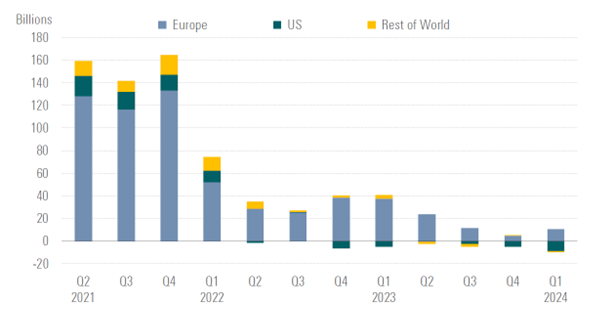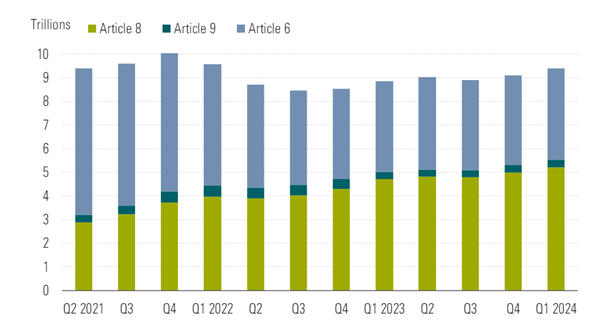With help from regulation, European ESG funds are still thriving

Globally, it may seem like ESG funds have been dealt a few blows recently. In the first half of 2024, four major US-based titans of the fund landscape – Invesco, J.P. Morgan, Pimco, and State Street – exited the Climate Action 100+ initiative, perhaps a signal that the tide is turning for sustainability funds. In the US, sustainable funds saw outflows of USD 8.8 billion in Q1 2024 – a record-setting worst performance in a single quarter.
But in Europe, the story looks very different. Some would say it’s to be expected. Europe is, after all, the world’s largest market for sustainable funds, accounting for 84% of sustainable assets as of Q1 2024. In that same period, sustainability funds saw inflows of USD 10.9 billion, more than double the previous quarter.
Exhibit 1: Quarterly Global Sustainable Fund Flows (USD Billion)

Source: Morningstar Direct. Data as of March 2024.
A robust regulatory landscape
Europe’s dominance in the ESG space has been bolstered by a swathe of ESG-focused regulations designed to increase the transparency around sustainable funds, which will help improve the overall quality of ESG data. By far the most expansive policy is the EU Sustainable Finance Action Plan, designed to change how investment firms, wealth and asset managers, banks, insurers, pension funds, and professional and retail investors consider ESG issues.
The plan has three core objectives:
- Direct capital flows to create a more sustainable economy.
- Ensure sustainability is factored into risk management.
- Foster transparency and create a long-term positive influence.
The key to the EU Action Plan lies in legislation. Notable legislation includes the EU Taxonomy Regulation and the SFDR.
EU taxonomy regulation
A classification tool that determines whether an economic activity is environmentally sustainable, the framework supports professional and retail investors, companies, and policymakers in identifying activities that contribute to environmental objectives. This supports the overarching aim of using capital flows to create a more sustainable economy.
The regulation offers a common language for sustainability. So, financial market participants better understand what the terms “green” and “sustainable” mean, which is key in preventing greenwashing. In practice, the framework functions by requiring certain financial market participants, firms, and EU member states to report on eligibility and alignment against six environmental objectives.
Sustainable Finance Disclosure Regulation (SFDR)
The SFDR is a core component of the EU Action Plan that requires managers to disclose:
- How sustainability risks are considered throughout the investment process.
- The different metrics used to assess ESG factors.
- How they consider and manage potentially harmful decisions (known as Principle Adverse Impacts or PAIs).
The goal of the SFDR is to elevate the quality of investment products, especially those that claim to have ESG credentials (known as Article 8 funds) or those with ESG objectives (Article 9 funds). The result of these strict disclosure standards is to increase transparency and combat greenwashing.
Exhibit 2: Quarterly Asset Breakdown by SFDR Classification (EUR Trillion)

Source: Morningstar Direct. Assets as of March 2024. Based on SFDR data collected from prospectuses on 98% of funds available for sale in the EU, excluding money market funds, funds of funds, and feeder funds. Chart from Morningstar’s SFDR Article 8 and Article 9 Funds: Q1 2024 in Review.
UK Sustainability Disclosure Requirements (UK SDR)
Beyond the EU Action Plan, other regulations are impacting the sustainable fund landscape. The UK SDR, which started to come into effect this year, has created four new voluntary product labels that asset managers can apply to investment vehicles, along with product- and entity-level disclosures. This new legislation aims to minimise greenwashing through a specific anti-greenwashing rule aimed at firms that make sustainability-related claims in their marketing about either their products or services.
The four new labels are:
- Sustainability Focus – Assets that focus on sustainability.
- Sustainability Improvers – Assets that aren’t currently sustainable but are set to improve over time.
- Sustainability Impact – Focused on solutions to sustainability issues to achieve a positive impact.
- Sustainability Mixed Goals – Assets focused on one of the three areas above.
TCFD reporting
The final pro-ESG framework comes from the Taskforce on Climate-Related Financial Disclosures (TCFD). As of 2023, the TCFD's recommendations have been publicly supported by almost 5,000 organisations across more than 100 jurisdictions, representing a combined market capitalisation of $29.5 trillion (£23.5 trillion).
The TCFD recommends that organisations report on four core thematic areas: governance, strategy, risk management, and metrics and targets. For example, reporting on Scope 1, Scope 2, and Scope 3 greenhouse gas emissions would fall under metrics and targets, while reporting on board oversight around climate risks would come under governance.
Looking to the future
While regulations vary by jurisdiction, they’re all interconnected by a common theme – data. Think of it as a cyclical and iterative process. To exist, regulations and frameworks demand data. As they come into force, the data quality improves over time. With higher-quality data, regulations and frameworks can be refined, or new ones can be created. And so on.
That’s why fund selectors must have access to robust, transparent, and insightful data. From navigating new regulations to adapting to changing client preferences and demands, data is the foundation of any successful investment strategy.
Learn more about how Morningstar can support your data and analytics needs at every step of the journey. To stay up to date with our latest insights, from fund selection and equity research to financial regulations, sign up for our newsletters.
